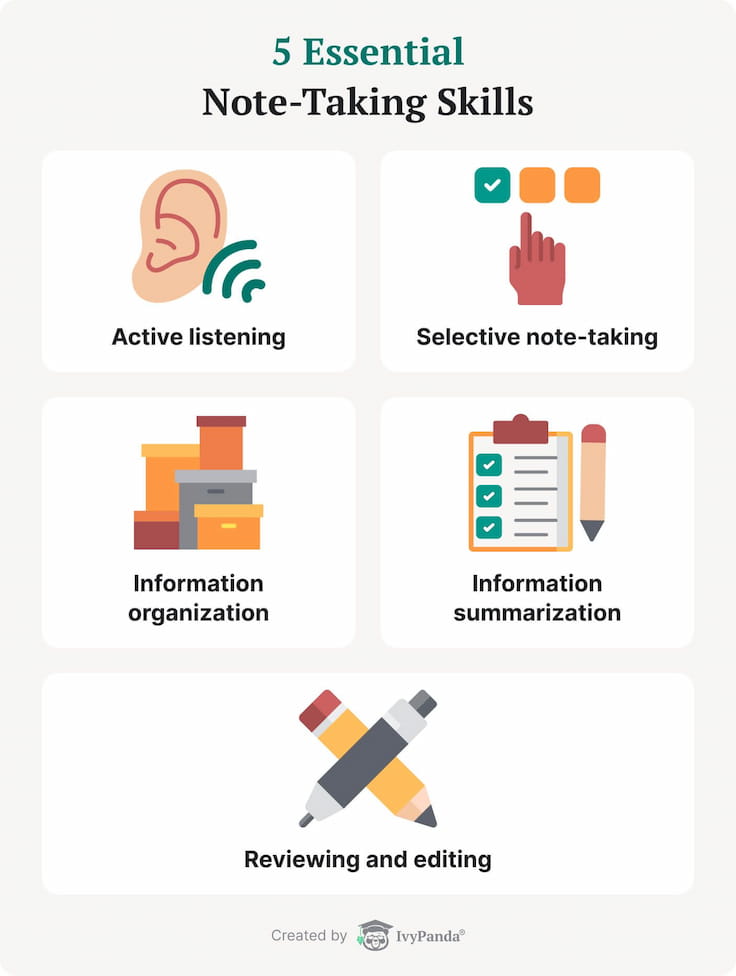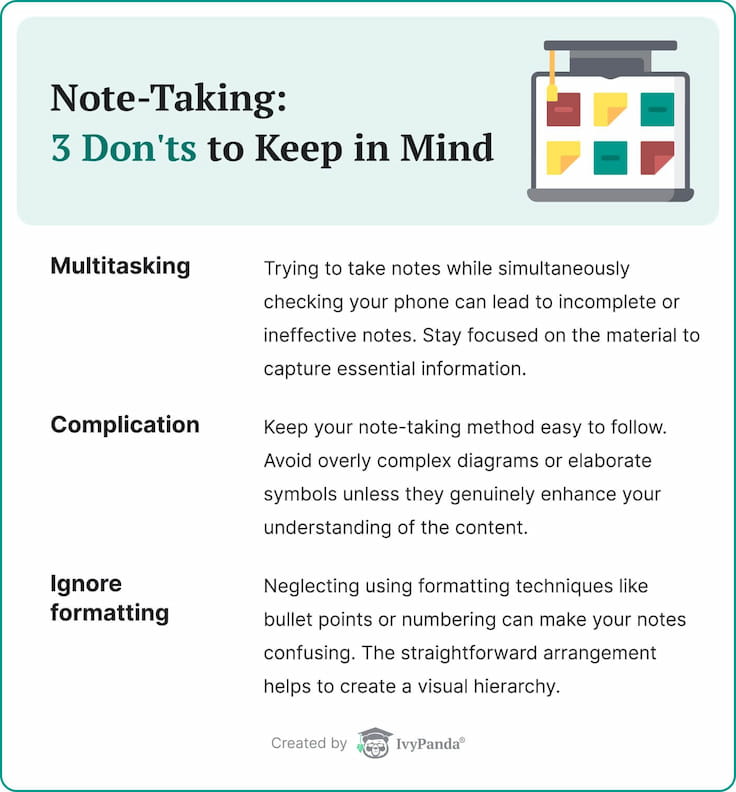Automatic Notes Generator for Students
🔥 Automatic Notes Generator: Tool Benefits
For many students, making notes is a tedious and time-consuming process. That’s why we’ve developed an auto notes generator to ensure that you get reliable summaries of paragraphs, chapters, and entire works. Several features make it a powerful addition to everyone’s daily studies.
🤔 Why Should I Take Notes?
There are several reasons why taking notes benefits your academic success:
- It lets people process information and remember it better.
- Additionally, taking notes can help you become more attentive during lectures and classes, as it activates metacognitive skills.
- A good maker of notes quickly establishes the most critical information in academic texts.
- Notes are handy for summarizing a topic, as they help organize and learn new material.
📝 5 Essential Note-Taking Skills
Taking notes may seem like nothing more than mindlessly repeating spoken or written words on paper and in online documents. Getting helpful notes in academic pursuits requires having a set of critical skills.

- Active listening. This skill lets note-takers focus on the speaker and comprehend their presentation. It involves insulation from distractions and asking questions about things one doesn’t understand. This way, collegegoers capture the most essential information in their notes.
- Selective note-taking. This skill allows you to note only the critical data. After all, notes shouldn’t read like a transcript of a lecture. Selective note-taking lets students concentrate on essential concepts and points, reducing time spent annotating irrelevant things.
- Information organization. This approach allows students to structure notes and understand them better. It involves using numbers or bullet points, highlights, and abbreviations. Structure makes notes more organized and easy to understand.
- Information summarization. Trim down your notes to their essence or rephrase them. Such actions help focus on the main parts of the topic and eliminate unnecessary details. It’s beneficial when revising information for an essay, a test, or an exam on a particular subject.
- Editing and reviewing. These methods are vital in improving the quality of notes. Reviewing also lets note-takers correct mistakes, clarify facts, and leave out unimportant information. Additionally, this allows them to check the validity of data and add missing facts.
Auto Notes Generator vs. Handwritten Notes
So, should students rely on their handwriting or trust automated notes? This question is not straightforward, as each approach offers clear benefits to collegegoers.
Auto Notes:
- Easier to edit and fix. Use text editing software to adjust note templates, their order, and content.
- Fast search. Most digital test solutions have inbuilt search functions, which allows spotting necessary notes in seconds.
- Reliable back-ups. Students find and manage digital notes quickly and effortlessly, as they are accessible from any device.
- Shareability. Having notes online allows seamless sharing and collaborative work.
- Customization. Many digital apps allow users to experiment with styles, format options, and colors, making notes more personal.
Handwritten Notes:
- Better retention. Writing by hand launches additional cognitive processes that enhance memory retention.
- Enhanced focus. This needs more attention than typing, which helps you stay engaged with the study content.
- Improved learning. Some students find that taking notes enhances their academic experience. It’s especially true for kinesthetic learners.
- Creativity. Handwritten notes foster a creative approach, encouraging the use of different writing styles and illustrations.
- Organization. Just like digital notes, their handwritten analogues can be organized for easy reference.
💡 Practical Note-Taking Methods
The process of note-taking isn’t just about lining them up in bullet points. There are six styles you should check out. Try using them in your daily studies!

- Charting method. Students use this style when dealing with data or fact-heavy study materials. It mostly relies on facts and keywords. Additionally, it requires you to establish the main topics of a chapter or a lecture. Here, columns are divided based on relevant keywords, each having related notes.
- Boxing method. Here, you can organize topics and notes into separate boxes. It can be done by hand or digitally. This approach lets you better segregate related ideas without confusing or mixing the concepts.
- Cornell method. This method proposes to divide pages into two vertical columns. The lower third of the page is left empty, giving the table a reversed T-shape. The left field often contains titles, keywords, and terms. The right side holds their description, and the bottom field offers a summary of the material.
- Mapping method. Collegegoers turn to this style when dealing with abstract and complex information. The technique has a main idea at the center and subtopic branches surrounding it. So, you can use this style to show connections between facts and ideas of a related topic.
- Outline method. The outlining technique offers a simple and intuitive way of taking notes. It prioritizes the information hierarchy, giving it a logical flow and organizing it. In this type, you put lecture topics on the far left side of the page, add sub-topics to the right, and expand them with facts, notes, and questions.
- Sentence method. This is one of the most effective styles for fast-paced lectures. Remember to number sentences as the talk continues.
Valuable Tips for Note-Taking
Like any skill, note-taking requires time and practice to master. You can utilize the following tips in daily studies to hone it and get better results with each session.
- Keep it concise. Your notes should summarize information instead of copying it. You’ll end up harming yourself by trying to rewrite books word-for-word.
- Learn active listening and reading. This involves attention, critical analysis, and actively participating in lectures by asking for questions and clarifications.
- Crystalize critical information. When listening to lectures or reading study books, pinpoint the most essential facts. Keep your eyes and ears peeled every time.
- Use abbreviations and symbols. Develop or adopt a system of annotations that saves time in writing complete sentences which will make it easier to follow speakers.
- Add visuals. Try sketching diagrams and illustrations to visualize concepts and ideas. Recording lectures and photographing the most fact-heavy slides will make things better click in your mind.

- Revise. After you take notes, read them later. Some can be poorly written or factually incorrect. Revision ensures that notes are properly structured, informative, and helpful.
- Stay consistent. When listening to lectures, be ready to take notes in their entirety and not just their separate parts. Pace yourself and attentively listen to critical facts provided by speakers.
- Leave grammar and spelling out. Lecturers don’t have the time to repeat themselves for your convenience. When taking notes, we recommend you focus and write down all the significant points. Don't worry if you make a typo or a grammatical mistake.
- Work on your handwriting. There’s nothing worse than writing notes for an hour only to discover that they are unintelligible. Practice your script if you want to record notes successfully.
We would be glad if our tool and guide helped your academic journey. Also, we encourage you to try the rubrics in your studies. If you have additional questions, please refer to our FAQ section.
❓ Auto Notes Generator – FAQ
Updated:
🔗 References
- Techniques and Tips for Listening and Note Taking. – UNSW Sydney, Australian University
- 5 Methods of Note-taking. – Angelina Burkholder, Concordia University Wisconsin
- Common Note-taking Methods. – University of Tennessee at Chattanooga
- Note-taking Techniques. – The Open University
- How to Take Notes and Study Smarter. – Murdoch University
- Effective Note-Taking in Class. – UNC, Learning Center
- Pros and Cons of Typed, Digitally Handwritten, and Paper Notes. – Cole Navin, University of Wisconsin System